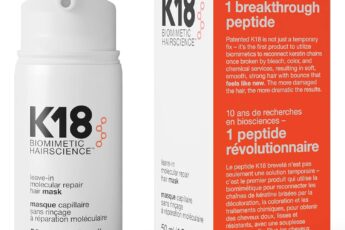Ever run your fingers through your hair and think, “What happened?!” only to feel rough, tangled strands that seem to have a mind of their own? Or looked in the mirror and noticed your hair is dull, lifeless, and just… sad? Yep, I’ve been there too, more times than I care to admit. One day, my hair was fine, and the next, it felt like straw.
Most of the time, what’s going on isn’t just dryness or a bad hair day—it’s hair cuticle damage. And the earlier you recognize the hair cuticle damage signs, the better your chances of saving your hair and getting it back to soft, shiny glory. So let’s chat, like friends sharing secrets over coffee, and I’ll show you how to spot if your hair is struggling.
Table of Contents
Key Takeaways
- Hair cuticles are the protective outer layer and crucial for smooth, shiny hair.
- Rough, brittle hair and frizz are classic hair cuticle damage signs.
- Dullness, split ends, tangling, and color fading also indicate cuticle issues.
- Heat, chemicals, environment, and rough handling are common causes.
- Gentle hair care, protective styles, and deep conditioning can help repair and prevent damage.
- Recognizing signs early is the key to healthier hair.
What is a Hair Cuticle?
Before we dive into the signs, let’s talk about what a cuticle actually is. I promise I’ll keep it simple. Think of your hair like a pencil. The cuticle is the shiny outer layer that protects everything inside. It’s made up of tiny overlapping scales—like shingles on a roof. When these shingles lie flat, your hair reflects light, feels smooth, and behaves nicely.
But when those scales lift, chip, or break, your hair starts acting up. It gets rough, tangles easily, frizzes out of control, and loses shine. I remember after a summer of beach trips and heat styling, I ran my fingers through my hair and actually felt it crackle. That was my first real wake-up call: my cuticles were in trouble.
The cuticle might seem small, but it’s the hero of hair health. Keep it happy, and your hair will look amazing. Ignore it, and your hair will start sending distress signals—signals we’ll get into next.
Also Read: Hair Botox vs Brazilian Blowout: The Truth About These Game-Changing Treatments
Common Causes of Hair Cuticle Damage
So why does this happen? Honestly, our hair goes through a lot, and it’s easy for the cuticles to get roughed up. Here are the main culprits:
- Heat Styling: Flat irons, curling irons, blow dryers… they’re hair’s worst enemies if overused. Even when I try to keep it to a minimum, one quick straighten or curl can leave my hair rough the next day. Over time, the scales on the cuticle start breaking.
- Chemical Treatments: Hair dye, bleach, relaxers… yeah, these are fun for a new look, but your cuticles pay the price. I once did a quick at-home bleach experiment (don’t try this at home!) and my hair instantly felt like straw. Lesson learned.
- Environmental Damage: Sun, wind, pollution… they all slowly wear down the cuticle layer. I love sunny beach days, but without protection, my hair loses moisture and shine fast.
- Mechanical Damage: Brushing, combing, tight hairstyles… even the way you sleep can affect your hair. Tight ponytails or braids might look cute, but over time they stress the cuticle.
- Overwashing and Harsh Shampoos: Stripping your hair of natural oils leaves the cuticle vulnerable. I switched to sulfate-free shampoos a while back, and my hair finally started feeling softer.
Basically, every time your hair gets stressed by heat, chemicals, the environment, or even rough handling, the cuticle takes a hit. And those hits show up as clear hair cuticle damage signs.
Hair Cuticle Damage Signs
Okay, here’s the part you’ve been waiting for: how to tell if your hair cuticles are actually damaged. I’ll walk you through the signs I always look for.
1. Rough or Brittle Hair
Your hair should feel smooth, right? If it’s rough or straw-like, that’s a warning. I remember brushing my hair one morning and hearing a faint snapping sound—it was brittle. My hair had lost moisture, and the cuticles were basically waving a red flag.
2. Frizz and Flyaways
Frizz isn’t just annoying—it’s a cuticle issue. When the protective scales lift, moisture sneaks in and makes your hair poof in every direction. Rainy mornings? Total frizz apocalypse. I’ve learned to embrace frizz in a pinch, but it’s definitely a sign your hair is struggling.
3. Dullness
Healthy hair shines because the cuticles lie flat. If your hair looks flat or lifeless, that’s another signal. I used to blame my shampoo for dull hair, but even after switching brands, the real problem was damaged cuticles.
4. Split Ends and Breakage
Nothing says “cuticle in trouble” like split ends. When the tips of your hair start splitting or snapping, that’s your hair saying it can’t hold itself together. After a week of heavy heat styling, my ends usually look like tiny fireworks going in every direction. Regular trims are my saving grace here.
5. Color Fading
If your dyed hair loses vibrancy faster than it used to, your cuticles are struggling. The lifted scales just can’t hold onto the color molecules, leaving your hair looking dull and uneven. I’ve noticed this every time I colored my hair without deep conditioning first.
6. Tangling
Ever notice how some hair knots like crazy? That’s the cuticle acting up. Rough or raised scales make strands catch on each other. Detangling becomes a battle, and that’s why I always use a wide-tooth comb and leave-in conditioner after washing.
Recognizing these signs is crucial. Think of them as SOS signals from your hair. The sooner you notice, the sooner you can help it recover.

How to Check Your Hair Cuticles at Home
You don’t need a fancy microscope to check your hair. Here are a few simple ways I do it myself:
- Finger Test: Run your fingers from root to tip. Rough patches or snagging? Cuticle distress.
- Light Test: Look at your hair in natural light. Dull, uneven areas indicate lifted cuticles.
- Water Test: Drop a strand in water. If it floats instead of sinking, it might be porous from cuticle damage.
These little tests are my secret for catching problems before they get out of hand. It’s like getting a warning signal straight from your hair.
Quick Tips to Protect and Repair Hair Cuticles
Here’s the good news: cuticle damage can often be managed or repaired if you act early.
- Limit Heat Styling: Give your hair breaks. Air-dry when possible. When using heat, keep it low. I try to straighten my hair just twice a week now, and it feels way healthier.
- Avoid Harsh Chemicals: Gentle dyes, minimal bleaching, and proper aftercare make a big difference. I always follow up color treatments with deep conditioning.
- Use Gentle Shampoos and Conditioners: Sulfate-free products keep the cuticles intact. Switching to these was a game-changer for my hair.
- Deep Conditioning and Hair Masks: Weekly treatments like coconut or argan oil restore moisture and smooth cuticles. I love slathering on a mask while watching Netflix—it feels like a mini spa for my hair.
- Protective Hairstyles: Loose braids, buns, or twists reduce friction. Avoid tight ponytails that tug at your hair.
- Observe Early Signs: Roughness, frizz, and dullness are your early warnings. Acting on them early prevents bigger problems later.
Even small changes make a noticeable difference over time. Treat your hair gently, and it will reward you.
Check Out: Powerful Hair Follicle Stimulation Methods That Actually Work
Conclusion
So, there you have it—your guide to spotting hair cuticle damage signs. Roughness, frizz, split ends, dullness, tangling, and color fading are all signals your hair cuticles are struggling. But the best part? With a little awareness and care, your hair can recover.
Pay attention to what your hair is telling you. Make small changes, protect it from heat and chemicals, condition regularly, and give it a little love. Think of it as listening to a friend who’s quietly asking for help—it’s worth it. Your hair will thank you with softness, shine, and strength.
Frequently Asked Questions
Can damaged cuticles grow back?
Not exactly. The cuticle itself doesn’t regenerate. But healthy hair growth comes from the follicle, so trimming damaged ends and protecting new growth helps a lot.
How do I know if my hair is damaged or just dry?
Dry hair might feel rough temporarily but softens with moisture. Damaged hair stays brittle, frizzy, and dull even after conditioning.
Which products help repair cuticle damage?
Deep conditioners, leave-in treatments, oils like coconut or argan, and protein treatments can help temporarily strengthen hair and smooth cuticles.
Does frequent coloring damage cuticles?
Yes. Repeated chemical treatments lift and weaken the cuticle, leading to frizz, dullness, and breakage. Gentle products and protective care help minimize damage.
Can brushing prevent cuticle damage?
Brushing gently with a wide-tooth comb or soft brush can help, but aggressive brushing or brushing wet hair can worsen damage.



